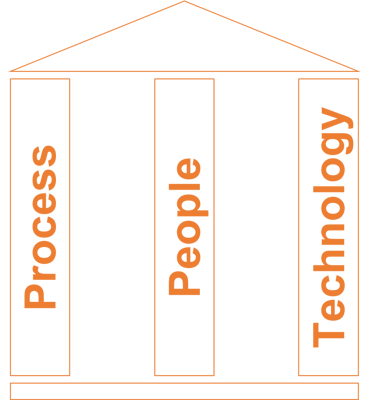We work in an age where it’s possible to “solve” nearly every business problem with technology.
This is why it can be extremely tempting, when you identify a particular issue in your business, such as a lack of effective contract management, to search for a technology solution, find a well-reviewed one, and move quickly to implement it.
Then all you need to do is set up a virtual training session, invite your team and let them get on with it. Job done and you can then move on to the next problem, right?
Not exactly.
Let’s take an example - you’ve just missed a renewal date for a major contract that you would have wanted to renegotiate.
You don’t want that to happen again, so you start looking for "contract management solutions", set up some trials, have some demo calls, select a preferred one, sign up and start using it. What happens then?
Twelve months later, you miss the renewal again. Or perhaps this time you fail a compliance audit because your supplier record keeping isn’t up to scratch. Or you find out you’re still paying two different companies to do the same work for different parts of your business.
These were all scenarios that you were expecting to avoid with your shiny new solution.
So what’s going on?
The Three Pillars
In a previous Gatekeeper article, one of our contributors, Elizabeth McNeese, described the three pillars of any business as being Process, People and Technology.

To solve any one business problem, you need to have addressed each of these three aspects and, most importantly, in that order.
In the example at the start of the article, the problem is that we’ve skipped the Process and the People and moved directly to the Technology.
And this is often understandable. As Elizabeth further elaborates it’s considered “safe” to invest in technology as a solution because you are often told that “investing X, will generate Y” and therefore it’s easy to put together a business case.
Focusing instead on the greyer areas of Process and People can prove more difficult. However, aligning both these areas to your planned technology is absolutely vital to successful investment.
The three things you must do before selecting a contract management solution are assess your Plan, Process and People - treating them, at first, as separate business entities.
Below, we look at these pillars and the approach you should take to analysing them - ahead of making decisions about the technology you want to implement.
1. Document your ideal Process
First of all, it has to be said that it’s very difficult to look at the Process in isolation from the People. And it’s okay to work on them together. However, if you can look at Process independently then it can bring greater clarity to your thinking.
This is because when you consider your ideal process, you might not currently have the right people in place to enact it, or perhaps you anticipate resistance to change from existing team members.
This purpose of this stage is to create the optimal process and if you start off by making concessions and compromises then you’ll never get the opportunity to see what that looks like.
Plus, you can always make adjustments further down the line to the process if you need to.
If we again use Contract Management as an example you might look to consider the following process components:
- Mapping your workflows for the full contract lifecycle, including initiation, sign-off, renewal and close-out. Which departments need to be involved, at what stages, and what actions do they need to carry out.
- How many contracts will need to be managed - both historical and new
- Timeframes and SLAs for each of your process steps. What is optimal and what is reasonable? What’s unacceptable?
- How can you minimise business risk at each stage?
- What are the Key Performance Indicators (KPIs) for each stage and how are they being measured?
- What are the key data security requirements around hosting and penetration testing?
Once you have a preferred process, and documented it in some way, it’s time to consider the people resources and how they fit in.
2. Understand your People
It’s a cliche but your people are your business’s most valuable asset. You need them to be bought in and aligned properly to solve your business problems.
Therefore, before you go “solving” their issues for them you need to make sure that all the relevant people are consulted and their situations understood.
In general terms, the questions that need to be asked are:
- Who is affected by this particular business issue?
- What is the current impact of it?
- What is the outcome we’re looking for when the issue is fixed?
- Who will be working on this once we’ve solved it?
- What resources can we devote to implementing a new solution?
The answers to these questions may result in changes to your initial process and refinement until you’ve got the best working model.
You might also identify the need for more or fewer people in the business to make the solution work.
3. combine your outputs
When you combine your outputs for the Process and People stages, you’ll have the basis for a clear set of requirements for your technology solution.
In the case of Contract Management, you’ll understand, amongst other things:
- How many people need to have access
- Who needs to have administrator rights and who needs limited access
- What the messaging and escalation capabilities need to be
- Training requirements
- How many contracts will need to be managed
- What your ideal workflows look like and whether they can be supported
- Where your data needs to be hosted for compliance purposes
- Timeframes for implementation
You’ll also have the basis for your business case as you should be able to quantify the additional revenue or the savings that the new solution will drive.
Based on this business case, you’ll also be able to formulate a view on the appropriate budget you’ll be able to commit to whatever solution you select.
Only at this point, should you then go looking for the right technology solution
choose Technology that aligns to process and people
As we said, this is the last piece of the puzzle. Once you’ve established your requirements, based on your Process and People assessments, it’s time to go to market and see what’s available.
Your initial conclusions and your estimated budget might dictate some of your options but you’ll go into the process with a clear understanding of what you need to solve your business problem.
To continue the Contract Management example, based on those initial assessments, something as basic as an Excel spreadsheet could be the appropriate solution. If you have a minimal number of contracts and little need for collaboration or automated messaging, you could decide that this is sufficient.
However, if you’ve gone to the trouble of a thorough assessment of your Process and People, the chances are that you’ve already established that something more robust is required.
It then becomes easier to audit and appraise each solution.
What this whole procedure also prevents is the scenario laid out at the start of this article, where the same mistakes are repeated each year.
Putting new technology in place isn’t going to resolve your business issues if it’s not supported by robust processes that have been adopted by the people in your business.
Renewals will still be missed for example, if people aren’t capturing renewal dates into your chosen solution along with notice periods, and then setting the appropriate triggers to make sure that people are notified at the right times.
Knitting these three elements together is how true value is gained from new technology.
At Gatekeeper, we speak to lots of businesses about their contract management maturity and what they require from a potential Contract Management Solution.
We are also realistic about the process that people will have gone through before contacting us. Not everybody comes to us having already mapped out their Process and People requirements.
However, we are adept at helping companies through this process and will happily recommend alternative options if, on reflection, there isn’t going to be a good fit between them and Gatekeeper.
This ensures that we work with companies we know can gain the maximum value from our solution.
If you believe your business could benefit from a contract management solution then contact us today and we can discuss your business and your requirements.
Alternatively, if you’re looking for advice on how best to manage your contracts a good place to start is with our free 38-page ebook - The Complete Guide to Contract Management.

















.png)
.png)
.png)
-4.png)